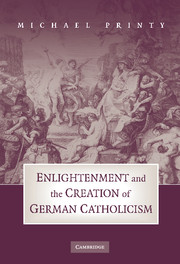Book contents
- Frontmatter
- Contents
- Acknowledgments
- 1 Introduction
- Part One PERFECT SOCIETIES: RETHINKING THE CHURCH AND THE STATE
- Part Two THE UNIVERSAL CHURCH AND THE UNIVERSAL CLASS
- 6 Catholic Enlightenment and the Search for a Bourgeois Catholicism
- 7 A Program for Reform
- 8 Pastors of Enlightenment: Reforming the Secular Clergy
- 9 Gallican Longings: Nation and Religion in the German Enlightenment
- 10 Conclusion
- Bibliography
- Index
6 - Catholic Enlightenment and the Search for a Bourgeois Catholicism
Published online by Cambridge University Press: 02 July 2009
- Frontmatter
- Contents
- Acknowledgments
- 1 Introduction
- Part One PERFECT SOCIETIES: RETHINKING THE CHURCH AND THE STATE
- Part Two THE UNIVERSAL CHURCH AND THE UNIVERSAL CLASS
- 6 Catholic Enlightenment and the Search for a Bourgeois Catholicism
- 7 A Program for Reform
- 8 Pastors of Enlightenment: Reforming the Secular Clergy
- 9 Gallican Longings: Nation and Religion in the German Enlightenment
- 10 Conclusion
- Bibliography
- Index
Summary
It is a shame that the German Catholic church did not have its own Sarpis and Richers! For it was exactly in this period [under Ferdninand II] that it received the oppressive yoke … Their religion fell into the hands of the Jesuits, and, what is worse, in the hands of the worst of their order. … What the Jesuits were able to achieve in other states only with violent cunning … they were able to do in Germany practically unnoticed and for a much longer period of time than in other states, without great political revolutions.
– Peter Philip Wolf, History of the Roman Catholic Church under Pius VICATHOLIC ENLIGHTENMENT AND REFORM CATHOLICISM
The reform program of educated German Catholics represented the culmination of several generations of pious renewal and religious reform. As such, it was part of a broader Catholic Enlightenment throughout Europe. But reform Catholicism in Germany had its own dynamic and set of problems that distinguished it from other such programs in the Catholic world. The most important of these were the political fragmentation of the Holy Roman Empire, the strength of Baroque Catholicism, and the biconfessional nature of German society. What the German reformers had in common with the Enlightened Catholic brethren was an animosity to the Jesuits that persisted even after the suppression of the Society in 1773.
This revolt against the Jesuit fathers, however, was only the tip of the iceberg.
- Type
- Chapter
- Information
- Enlightenment and the Creation of German Catholicism , pp. 125 - 143Publisher: Cambridge University PressPrint publication year: 2009

